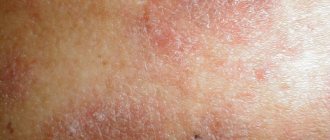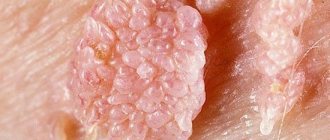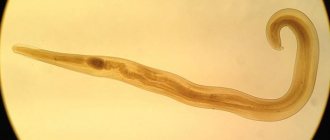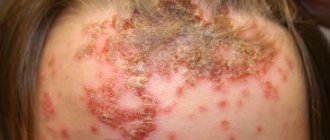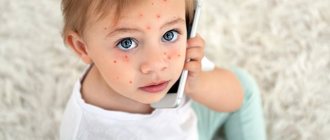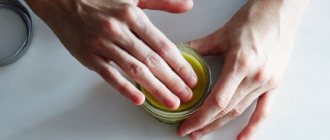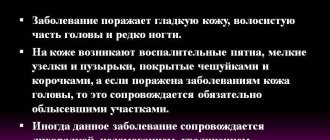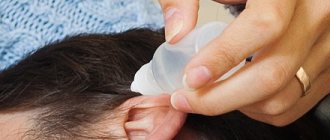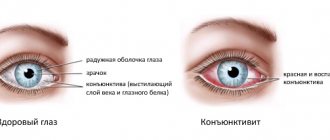The list of common skin diseases in children includes lichen. It is characterized by damage to one or more areas of the skin, with pigmentation disorders (lightening, darkening), hair loss, itching and flaking. There are different types of infection (ringworm, pink, pityriasis, shingles). Its causative agents are fungi and viruses. More often, lichen affects children attending various child care institutions.
What is lichen
The term lichen in a child is understood as a collective concept meaning a fungal and viral disease. The classification includes several types of pathology, differing in course, causes and external manifestations. Ringworm on the skin of a child occurs more often under the age of 14 years.
When the first unusual rash appears, parents should contact a dermatologist, infectious disease specialist, or pediatrician as soon as possible. This is due to the high degree of contagiousness of the disease. For this reason, sick children pose a great threat to the people with whom they come in contact.
Viral and fungal lichen requires timely initiation of treatment. Advanced forms are difficult to treat, and it takes a lot of time. Depending on the type, ringworm may resolve on its own. Some variants of the disease return again with the same symptoms, while others become chronic.
The incidence rate increases significantly in the summer and autumn seasons. During this period, specific signs appear and treatment of lichen must be comprehensive in order to eliminate the manifestations in a short time.
The most favorable period for the development of the disease, according to Dr. Komarovsky, is a warm time, when optimal conditions are created for the reproduction and spread of infection. Heat, moisture in the environment, and increased sweating help increase the permeability of the skin. This makes it easier for the infection to break through the protective barrier. Symptoms of lichen in newborns and older children appear when the body's defenses against pathogenic microorganisms are insufficient.
Kinds
Of the total number of skin diseases, this disease is one of the 10 most common. The following types of lichen in humans are distinguished:
- shearer;
- pink;
- encircling;
- red;
- pityriasis
Important! Each of these forms has its own causes, specific symptoms and treatment.
To make a correct diagnosis and prescribe treatment, you need to distinguish lichen alba in the photo, pink lichen from other skin diseases.
Diagnostic methods
If you suspect lichen, take your child to see a pediatric dermatologist. The doctor conducts a survey and examination - visually and using a mercury-quartz magnifying Voodoo lamp. Using the device, a specialist identifies skin pathologies invisible to the naked eye. Thus, different types of lichen glow in different shades of the brown-yellow spectrum.
To accurately determine the type of pathogen, a microscopic examination of a scraping of the affected skin is prescribed. If necessary, a biochemical blood test and a general urine test are additionally performed. The obtained diagnostic data allows us to select the most effective treatment tactics.
Ringworm
Depending on the type of microorganism, the disease is also called microsporia, which is associated with the pathogen. It is a Microsporum fungus that can infect hair, nails, skin and eyelashes. Microorganisms are classified as dermatophytes due to their favorite localization - the skin. Ringworm is more common in children than in adults. This is due to frequent contact with animals. Another type of lichen in humans is considered trichophytosis. It is caused by fungi of the genus Trichophytos.
Their body is most susceptible to infection due to the structural features of the skin, which at an early age is very thin and does not have a good protective coating. Due to insufficient development of the barrier, pathogenic microorganisms quickly penetrate the tissues and multiply in conditions favorable to themselves.
Reasons for development
The fungi that cause shingles are spread from animals. Depending on the source that infects the child, several forms of the disease are distinguished - anthroponotic and zoonotic. In the first case, humans are considered the root cause of pilaris, and in the second, animals.
The most likely route is stray cats and dogs. Ringworm is also transmitted from sick people. Infection occurs through communication with it or contact with shared devices. Most often, towels, washcloths, bed linen, and dishes become intermediaries in the spread of infection.
Kinds
For ringworm symptoms to appear, special conditions must be created to facilitate penetration. Further development is possible only if one or more factors are present:
- hypovitaminosis;
- chronic foci of infection;
- acute diseases;
- weakened immune system;
- damaged skin.
Lichen manifests itself in several forms - superficial, chronic and infiltrative-suppurative. Each of the above has its own incubation period and specific course. If an infiltrative-suppurative type of lesion develops, then it will be possible to remove the lichen only after 2 months.
Symptoms
The incubation period for the superficial form is about 1 week. With infiltrative-suppurative microsporia, the process is delayed for 1-2 months. In the case of a chronic disease, canine and feline lichen constantly appears when the superficial form is not treated sufficiently.
After the end of the incubation period, specific symptoms appear that allow you to understand the diagnosis:
- Spots on the skin similar to lichen. The white scales that are located on the surface of these formations make the diagnosis easier. The size of the spots can be large or small.
- Ringworm on a child’s head looks like lesions with no hair. They do not fall out, but break off, which creates the impression of stumps in this place.
- Nails begin to peel, become dull and gray. Their defeat is rare.
- Some areas with spots tend to merge. These areas are very itchy.
- Inflammation is not typical except in cases where a secondary infection is associated.
Ringworm spots on the body look like spots that are flaky and have a pink tint. The formation is considered vesicular, which is associated with the formation of a small vesicle in the center. Then it bursts and the area becomes covered with a crust. Lichen can be identified by a spot surrounded by a bright red ridge that is raised above the skin level.
It is not uncommon for additional formations of a smaller diameter to appear on the back, face, limbs, and neck. This feature is called “ring within a ring.” To have a complete understanding of the disease, you need to know what lichen looks like in a person in the photo.
When microspores penetrate the layers of the skin of the scalp, bald patches of various sizes are formed, but with clear edges. If it is cat lichen or was transmitted from a dog, then the areas will look large - up to 10 cm in diameter. When fungi enter after contact with a sick person, the lesions look much smaller in size. In the photo of the child's lichen, upon examination, bald patches and small stumps with dull broken hair are clearly visible.
Pityriasis rosea
The disease also has a second name - Zhiber's lichen. It belongs to a group of viral infections in which the main factor for development is considered to be hypothermia or allergies. Most often occurs in children under 12 years of age.
The initial stage involves the presence of red spots on the skin of the abdomen and limbs. Their shape is most often oval. The first elements are called maternal plaques. In rare cases, parents note a deterioration in general health before the appearance of rashes. After 1-2 days, the red areas begin to peel off. Then, after a few more days, lichen appears on the body, face, and chest. New areas affected by the fungus appear smaller.
Most often, elements appear in skin folds, which is considered their most common location. As scales form, the center of the spots becomes yellow, and the edges acquire a red tint. Due to this type of elements, they are called medallions.
In some cases, instead of a red spot, blisters form on the neck or other part of the body. Full recovery occurs after 2 months. The disease is transmitted by contact from a cat to a person or spreads between people. For this reason, isolation of patients is required for the entire period of illness.
Shingles
The disease is caused by the herpes virus. Children over the age of 12 are prone to it. Symptoms of shingles appear only in those who have already had chickenpox. From this moment on, type 3 virus remains in the body for life. A number of predisposing factors contribute to the appearance of the disease:
- frequently ill children;
- newborns;
- with oncology;
- in the presence of chronic diseases;
As soon as the immune defense becomes insufficient, the herpes virus, which is in a dormant state, begins to actively manifest itself.
Symptoms
It is not immediately possible to recognize herpes zoster in children. Elements often appear on the leg and torso. The following signs are characteristic:
- Increase in body temperature.
- Chills.
- Enlarged lymph nodes.
- Burning, stinging or itching in the areas where the rash appears.
- Decreased appetite.
At the beginning of its development, the first signs in the form of ARVI may appear. After 1-2 days of development of nonspecific symptoms, lichen colds begin to actively manifest themselves. Pink bubbles appear along the nerves (intercostal spaces are a common location for rashes). Gradually they merge. After a week, the elements dry out and the surface becomes covered with crusts.
Knowing everything about lichen, parents should exclude the possibility of scratching the elements on the child’s skin. At an older age, he needs to explain this. The presence of an open wound in an infant when scratching will lead to a secondary infection. Against the background of reduced immunity, it will begin to actively multiply, which will result in the addition of concomitant pathology.
Ringworm
The presented form is not common in childhood. Its etiology is varied and in some cases, it is not possible to determine the source. The causes and treatment are closely related. Medicines are prescribed after identifying the factor that provoked the development of the disease. The etiology of lichen planus consists of the following options:
- hereditary predisposition;
- drug intoxication;
- autoimmune factors;
- allergic lichen;
- neurogenic form;
- viral infection.
There are several forms along the way - acute, subacute and chronic.
Symptoms
The onset of the disease occurs differently in each child. Lichen planus appears after 7-10 days against a background of general malaise, weakness and loss of appetite in the form of a rash. For other patients, this form of development of the disease is not typical and they develop specific elements without affecting their well-being.
The most favorite places for rashes of red lichen are identified:
- underbelly;
- on the fingers;
- in the lumbar region;
- on the butt;
- elbow bends;
- on the feet;
- axillary fossae.
Ringworm most often does not appear on the head, which becomes one of the main distinguishing features. The rash consists of papules that do not have a cavity inside. They have an umbilical depression in the center of their elements and a polygonal shape.
Pityriasis versicolor
Tinea versicolor is a disease that is not infectious in nature. The main cause is considered to be microorganisms that are represented in the body by opportunistic flora. Ringworm is characterized by spots that have brown and yellow shades. Only the stratum corneum is affected.
Important! The disease is not a contagious form, unlike those listed above.
Treatment and relapse prevention are important for children. There are no complications after the illness. Many parents begin therapy for their children for aesthetic reasons. The reason is noticeable spots on the skin that spoil its appearance. Therefore, treating patients with this form at home is not prohibited.
The following factors create favorable conditions for the proliferation of microorganisms:
- Intense physical activity.
- Increased sweating.
- High ambient temperature.
- Wearing warm clothes.
- Taking antipyretic pills.
Rashes most often appear on the stomach, back, and torso. Rarely there are children with localized pityriasis peeling on the face in the cheek area, under the eyes, on the scalp. In addition to the appearance of scales, mild itching may bother you.
Video
The video Traditional Medicine presents various methods of treating lichen at home.
Do you have any questions? Specialists and readers of the KROHABABY website will help you ask a question
Was this article helpful?
Thank you for your opinion!
The article was useful. Please share the information with your friends.
Yes (100.00%)
No
X
Please write what is wrong and leave recommendations on the article
Cancel reply
Rate the benefit of the article: Rate the author ( 1 vote(s), average: 5.00 out of 5)
Discuss the article:
Treatment of ringworm
A pediatric dermatologist prescribes medications for local treatment of affected areas and oral administration. Parents should know how to treat lichen and follow all recommendations to prevent relapse of the disease. It includes:
- Preparations for local application.
- Forms for oral administration.
- Supportive therapy.
- Traditional medicine.
Ringworm ointment for children is used only after 2 years of the child’s life. Mycoseptin, Clotrimazole, and Ketoconazole are effectively used. It is recommended to smear the affected areas of the skin with salicylic ointment, sulfur-tar and sulfur ointment for lichen. In the pharmacy, according to a prescription, special medicines are prepared for some children - Vidal's milk and Lassar's paste. Treat stains with iodine and salicylic acid.
Knowing what lichen looks like in children, if treated in a timely manner, most often, local therapy is sufficient. When the forms are running, system tools are also included in the scheme. For this purpose, anti-lichen tablets are used. Griseofulvin is considered effective. The dosage is prescribed depending on age and severity.
With a mild course, it is important to be able to distinguish lichen from dermatitis. To understand the diagnosis of the child, additional studies are carried out to accurately determine the cause of the rash.
How to treat?
Question: how to treat lichen in children is a question for the average layman who requires a universal ointment or tablet.
It is immediately necessary to emphasize that treatment tactics, as well as rehabilitation time, depend solely on the severity and type of illness.
In addition, it is possible that temporary isolation of a sick baby will be required in order to localize the area where the infection is spreading.
The regimen, dose and procedure for taking medications is the exclusive prerogative of the attending physician.
All means are good for treating your child, be it traditional therapy or “grandmother’s” recipes that have come down to us from the depths of the gray Lukomorye, but have not lost their magical power.
| Medicines | Folk remedies |
| Shearer | |
| Antimycotics – antifungal medications (oral): Itraconazole, Fluconazole, Ketoconazole, Orungal, Griseofulvin. Ointments: Salicylic. Sulfuric. Sulfur-tar. Mikospor. Wilkinson's ointment. Lamisil. Prescription ointments (manufactured in pharmacies): Vidal's milk, Lassora paste. | Grated boiled beets, mixed in equal parts with honey. Rub into the affected area. Buckwheat decoction. One glass of buckwheat and two water. Boil until tender, pass the broth through a sieve. Cool and lubricate the sore spot. Cabbage leaf pulp . Grind in a blender. Mix 1:1 with sour cream - the life-giving potion is ready. Chamomile infusion . Pour a small spoon of chamomile petals with 200 grams of boiling water. Let cool. Wipe the affected area with a swab three times a day. Do not wash and let dry on your own. |
| Pink | |
| Erythromycin is an antibiotic. Acyclovir is an antiviral. Tavegil is an antihistamine. Hydrocortisone – hormonal, anti-inflammatory effect. Tsindol - dries the body and blocks inflammatory processes on the skin and the proliferation of microorganisms. Activated carbon – removes toxins. | Calendula ointment. Grind 10 g of dry calendula, add and mix with 50 grams of Vaseline. Treat the sore spot three times a day. Chamomile decoction and cabbage paste. The recipe is described above. Tar ointment . Birch tar and butter are mixed one to one. At night, lubricate the napkin and cover the sore spot. Yeast dough : a faceted glass of milk, 30 grams of raw yeast, 800 grams of flour, one egg, 2 large spoons of honey and 4 of the same spoons of vegetable oil. Apply the finished dough for two hours three times a day. Paper ash . Burn a blank white sheet of paper to ashes. Add 5 grams of alcohol. Rub the resulting composition into the affected area three times a day. |
| girdling | |
| Antiviral drugs: Acyclovir, Famvir, Valacyclovir, Valtrex. Antiviral ointments and gels: Zovirax. Acyclovir, Viru-merz. Hormonal agents: Prednisolone, Hydrocortisone. Strengthening the immune system: Neovir, Arbidol, Rimatodin. | Wormwood infusion. Pour a small spoon of chopped herbs with 100 grams of alcohol or a glass of vodka. Let it brew for a week. Shake regularly. Apply a cloth soaked in the solution to the affected area for 20 minutes. At the end of the procedure, lubricate the area with castor oil. Burdock decoction. Grind the burdock leaves. Pour 100 grams of boiling water over a large spoon of the starting material and steam for 5 minutes. Remove and cool. At night, moisten a napkin and wrap the inflamed area. Porridge from marsh cinquefoil . Pass the fresh herbs of the plant through a meat grinder. Apply the paste to the wound overnight. Herbal decoction . Take, mix and chop in equal parts: willow bark, blackberry leaves, tea rose petals, calendula flower, horsetail. Pour 50 grams of the mixture into three glasses of water. Bring to a boil, turn off the heat and simmer for another 15 minutes. Cool the resulting broth and filter. Before going to bed, moisten a napkin and cover the affected area. |
| Flat red | |
| Corticosteroids: Prednisolone, Metipred. Synthetic interferons: Neovir, Ridostin, Interferon-alpha 2b. Antihistamines: Parlazin, Zyrtec, Clemastine, Tavegil, Suprastin, Loratadine, Diazolin. Antibiotics: Metacycline, Tetracycline, Azithromycin, Erythromycin, Sumamed. Hormonal ointments: Hydrocortisone, Betamethasone, Flumethasone, Cloveit. Antiallergic ointments: Gistan, Fenistil. | Calendula oil. Pour calendula flower (50 g) into a clean bowl (200 g), pour in olive oil. Leave for 1.5 months, remembering to stir. Once ready, lubricate the sore spot regularly. Calendula ointment. Steam 200 g of calendula oil and 20 g of beeswax. Cool and refrigerate. During the day, treat the rash every four hours. Herbal infusion . Grind nettle leaves, elderberry flowers, juniper berries, dandelion roots and St. John's wort herbs - equally. Take two large spoons of the mixture and mix with boiled water (half a liter). Insist for an hour. Filter and refrigerate. Drink one hundred grams before eating. |
| Colored (pityriasis) | |
| Antifungal drugs (tablets): Ketoconazole, Oranozol, Orunit, Mycozoral, Fungavis, Itraconazole, Canditral, Itrazol. Creams, ointments: Bifonazole, Mycospor, Bifosin, salicylic lotion with chamomile, Clotrimazole, Terbinafine. | Tar soap. At any time of the day, soap the affected area once. Boric acid. Lubricate during the day after 4 hours. Vinegar solution . We dilute one to one 3% vinegar and iodine. We wipe the stains once a day. Wipe the affected area with 3% vinegar twice a day. A decoction of string or celandine . A large spoon of string and a glass of boiling water - brew. We insist for one hour. Filtering. We wet a napkin and cover the affected area for an hour. |
Video:
Treatment of pityriasis rosea
Treatment of pityriasis rosea should begin with the following groups of drugs:
- Antihistamines (“Suprastin”).
- Antibiotics (“Erythromycin”).
- Systemic interferons (“Ridostin”).
- Systemic glucocorticoids (“Prednisolone”).
Ointment for pityriasis rosea is used only after a doctor's prescription. When the first rash appears, it is not recommended to start treating the child on your own. Zinc ointment is prescribed for treating stains and Vishnevsky ointment and water-zinc mash. Antihistamines must be used. Calcium gluconate is used in 3-5 injections.
The duration of therapy depends on the severity. The effectiveness of a remedy for lichen is judged by the positive dynamics of the condition and the reverse development of the rash. Physiotherapy is used. PUVA therapy is aimed at slowing down the proliferation of cells in the spots. Ringworm in an infant is treated in this way for no more than 10 sessions.
If a child has tinea versicolor, topical corticosteroids are included in the regimen. Such patients must be given an individual dose of antihistamines. This is due to a possible allergic reaction to hormones. Lichen can be treated with retinol-based medications, which eliminate the itching sensation.
Folk remedies
Note: Home methods will only be effective in conjunction with drug therapy.
Traditional methods of treating herpes zoster :
- compresses with a decoction of burdock leaves;
- fresh white cabbage leaves;
- aloe juice or leaves.
Home therapy for pityriasis versicolor :
- treatment of affected areas with rosehip oil;
- compresses or rubbing with alcohol tincture of calendula;
- decoction of St. John's wort, celandine.
For ringworm , lotions containing 50 grams of fir oil diluted with 50 grams of vodka will help.
The pink type does not require mandatory medical treatment with external agents. Symptoms are relieved by rubbing with chamomile decoction and ointments to relieve itching.
Red view makes it easier :
- warm compresses with sea buckthorn oil;
- celandine decoction.
To relieve white type :
- aloe leaves;
- decoction of birch leaves.
Treatment of herpes zoster
Antifungal ointments will not be effective in this case. Acyclovir is a drug aimed at fighting viruses. The course of treatment for herpes zoster is 10 days. If pain occurs, Ibuprofen is used. If it is not possible to cure lichen and a secondary infection occurs, then antibiotics are needed. Levomekol ointment is used locally.
During the treatment of shingles, antiseptics are used as needed. The effective anti-inflammatory ointment “Sanaflan” will help you cope with itching. It is important to remember that washing with shingles is not recommended, but depending on the severity of the condition, the attending physician may recommend hygiene procedures.
Prevention - how to protect a child?
Some readers will find this section simply unnecessary. Because it will list measures that are simple to the point of naivety, which self-respecting people must, but also must, observe and demand the same from their children.
But don’t consider this as intrusiveness - we will repeat the lesson with you again:
- When returning after a walk, immediately wash your hands with soap. During the summer season, we strongly recommend using disinfectants. Don’t be lazy - check the thoroughness of the hygiene procedure performed by your baby.
- Strictly exclude children from contact with stray animals.
- Do not allow children to use other people's personal hygiene items: combs, washcloths, toothbrushes, towels.
- Do not allow yourself and forbid your children to try on other people’s clothes, shoes and hats.
- Regularly strengthen your child's immune system. To do this, use every opportunity: walks in the air, hardening, dousing with cold water, taking natural vitamins, a healthy and balanced diet.
- During the seasonal risk period, “get hooked” on a hypoallergenic diet. These are vegetables, meat, rice, potatoes, dairy products. They will become a natural shield for you during a viral attack.
We hope that after reading this educational material you have a real tool in the fight against this skin infection. And the folk wisdom that it is better to prevent trouble than to fight it will come in handy when it comes to skin disease.
Treatment of pityriasis form
For treatment, antifungal drugs are mainly prescribed for lichen. It is advisable to simultaneously carry out local and systemic therapy. This approach will reduce the frequency of relapses. On the recommendation of a doctor, the use of folk remedies for lichen in children is allowed.
The child's immune system is not sufficiently developed. For this reason, prevention is important to protect the child’s body from fungi and viruses. The main danger is the development of complications or the addition of a secondary infection. Timely seeking help and treatment will allow the child to quickly begin to fight the disease.
Watch the video - treatment of lichen:
Reasons for appearance
The peak incidence occurs in the summer, when suitable conditions for the development of the fungus are created. The infection is caused by opportunistic fungi Pityrosporum ovale, which are part of the skin microflora. However, under the influence of a number of external or internal factors that weaken the immune system, it begins to multiply uncontrollably, disrupting the production of melanocyte cells in the epidermis, which are responsible for the production of the melanin pigment. Thanks to it, the body becomes tanned under the influence of the sun, but hypopigmented spots are formed on the affected areas by the fungus.
Factors that activate fungal growth:
- frequent colds or respiratory infections;
- stress;
- mental stress;
- excessive sweating;
- failure to comply with personal hygiene rules;
- diseases (diabetes mellitus, thyroid dysfunction, obesity, premature puberty);
- diseases of the gastrointestinal tract;
- improper or poor quality nutrition;
- avitaminosis;
- hereditary predisposition (special composition of sweat);
- low-quality cosmetics for children's skin care;
- excessive use of antibacterial compounds for bathing and washing;
- Itsenko-Cushing syndrome.
